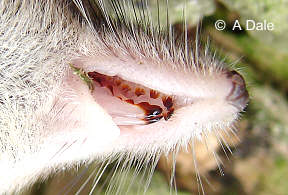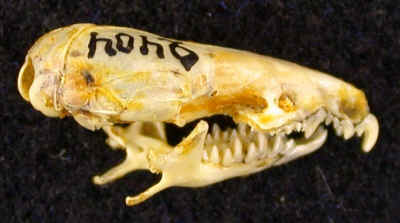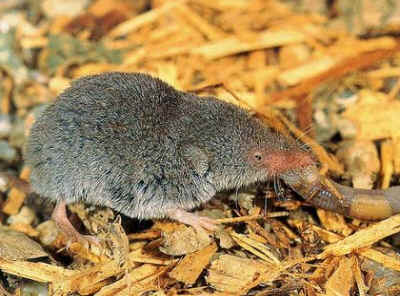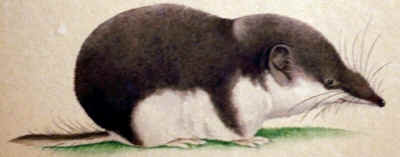
Juvenile northern short-tailed shrew, Blarina brevicauda. Photo by Jamie McCarthy. Creative Commons Attribution NonCommercial
| Insectivora | ||
| The Vertebrates | Soricidae |
| Vertebrates Home | Vertebrate | Vertebrate |
|
Abbreviated Dendrogram
Eutheria
│
├─Insectivora
│ ├─Micropternodontidae
│ └─┬─Erinaceomorpha
│ └─Soricomorpha
│ ├─Tenrecoidea
│ └─┬─Solenodontidae
│ └─┬─Talpoidea
│ └─Soricoidea
│ ├─Apternodontidae
│ └─Soricidae
│ ├─Crocidurinae
│ └─Soricinae
└─┬─Chrysochloroidea
└─Afrotheria
|
Contents
Index |
 Juvenile northern short-tailed shrew, Blarina brevicauda. Photo by Jamie McCarthy. Creative Commons Attribution NonCommercial |
Assuming, of course, that you haven't already met. The Soricidae are a family of small insectivorous mammals found throughout Eurasia, Africa and North America, with a small number of species extending to South America. By mammal standards, this is a fairly large family with about 370 species currently recognised and a small but steady trickle of new species still being published such as Sylvisorex akaibei from the Congo within the past year (Mukinzi et al., 2009).
 Caravan of house shrews, Suncus murinus. Photo from Osamu Matsuzaki. |
Living shrews are usually divided between two subfamilies, the Soricinae and the Crocidurinae, or the red-toothed shrews and white-toothed shrews respectively (Dubey et al, 2007). Red-toothed shrews, found in Eurasia and the Americas, are named after one of their most unusual features, red crowns to their teeth due to the deposition of iron in their enamel (this feature has been lost in a few soricine genera). White-toothed shrews are found in Africa and tropical Asia and make up for lacking the funky tooth pigment of Soricinae by including such creatures as the insanely over-developed hero shrew Scutisorex somereni and the bewildering diversity of the genus Crocidura with in excess of 150 species. Other notable features of shrews include the production by at least some species of toxic saliva, and the formation by young shrews of 'caravans'. One youngster will grasp its mother's rump in its mouth, its own rump will be grabbed by another, and so on until the entire brood forms a train by which the mother will lead it about. The young shrews will remain determinedly clinging to each other even picked up and dangled above the ground like a living monkey chain (Nowak, 1999).
 Close-up of mouth of a common shrew Sorex araneus showing the red teeth. Photo by A. Dale. |
Most shrews are terrestrial generalists though a number of species are semi-aquatic, particularly in the soricine tribe Nectogalini. The American and Pacific water shrews, Sorex palustris and S. bendirii, are capable of running short distances across the surface of water due to their small size and hairy feet. The little-known central African Ruwenzorisorex suncoides has large premolars that have been suggested to indicate a diet of molluscs. In contrast, the mole shrews of the genus Anourosorex are (funnily enough) mole-like burrowers feeding on burrowing insects and earthworms. - CKT100517
 Soricidae: extant shrews: > 20 genera)
Soricidae: extant shrews: > 20 genera)
Range: possibly from the Late Cretaceous. Certainly from the Late Eocene; cosmopolitan except for Australia, Antarctica, and southern South America.
Phylogeny: Soricoidea:::: Parapternodontidae + *: Crocidurinae + Soricinae.
Characters: head + body 3.5-18 cm [N99]; most very small, 2.5-180 g [V+00] (compare [N99]: 2-35 g, usually ≤ 18g); skull long, narrow [N99] & usually dorsoventrally flattened [V+00]; snout long & thin [V+00]; eyes tiny [V+00] and vision poorly developed [N99]; zygomatic arch absent [V+00]; postorbital process absent; pinnae sometimes conspicuous [N99] [V+00]; auditory bulla absent [V+00]; tympanic distinctively annular [V+00]; brain small, with smooth cerebra [N99]; dentary with well-developed double condyle, with non-articulating strip separating upper & lower condyles [MN93] [3]; diphyodont, with 1st set lost embryonically [N99]; dental formula 3/1-2, 1/0-1, 1-3/1, 3/3; I1 enlarged, with hooked end & with 1 cusp projecting ventrally at the base [N99]; i1 large with
 elongate, forward-projecting main cusp & well-separated smaller, distal secondary cusp; distal incisors, canines, & premolars small & peg-like; upper molars dilambdodont, with a strongly developed W-shaped ectoloph [N99]; M1 without mesially projecting parastyle [A+02$]; M1-2 with prominent buccodistal metacone [A+02$]; M1-2 with prominent linguodistal hypocone [A+02$]; lower molars with well-defined talonid basin [A+02$]; limbs short [N99]; digits 5/5 and usually unspecialized [N99] [V+00] [2]; plantigrade [V+00]; tibia & fibula fused [N99]; pelage dense [N99]; main senses are probably touch, hearing, and smell; some species with toxic saliva and i1 medial surface concave, associated with salivary ducts, for injection [V+00]; very high metabolic rate and highest oxygen content and heart rate in mammals [V+00] (compare [N99]: expressing doubt); common urogenital opening in most species. [N99]; rudimentary echolocation in some species [V+00]; notably solitary except during breeding season (one exception: Cryptotis parva) [N99]; high mortality from shock (handling, loud noises, change of environment, even thunder) [N99]; usually in moist environments (some exceptions) & some with frankly aquatic adaptations [N99] [V+00].
elongate, forward-projecting main cusp & well-separated smaller, distal secondary cusp; distal incisors, canines, & premolars small & peg-like; upper molars dilambdodont, with a strongly developed W-shaped ectoloph [N99]; M1 without mesially projecting parastyle [A+02$]; M1-2 with prominent buccodistal metacone [A+02$]; M1-2 with prominent linguodistal hypocone [A+02$]; lower molars with well-defined talonid basin [A+02$]; limbs short [N99]; digits 5/5 and usually unspecialized [N99] [V+00] [2]; plantigrade [V+00]; tibia & fibula fused [N99]; pelage dense [N99]; main senses are probably touch, hearing, and smell; some species with toxic saliva and i1 medial surface concave, associated with salivary ducts, for injection [V+00]; very high metabolic rate and highest oxygen content and heart rate in mammals [V+00] (compare [N99]: expressing doubt); common urogenital opening in most species. [N99]; rudimentary echolocation in some species [V+00]; notably solitary except during breeding season (one exception: Cryptotis parva) [N99]; high mortality from shock (handling, loud noises, change of environment, even thunder) [N99]; usually in moist environments (some exceptions) & some with frankly aquatic adaptations [N99] [V+00].
Notes: [1] this is a huge group, with over 20 extant genera and 300 species, to which we will one day have to devote an entire unit. [2] only one species has webbed feet. Most aquatic shrews have long hairs around the toes. These increase the surface area and trap air bubbles, allowing limited walking on the surface of still water. [N99]. [3] according to [MN93], the upper condyle is the original temporomandibular joint and is separated in life from the squamosal by a inter-articular disk. The lower joint is a simpler synovial joint without a disk. This "is accompanied by drastic functional rearrangement of the" jaw adductors, including loss of the deep masseter and insertion of the temporalis on the medial face of the coronoid. Of course this looks bit like Thrinaxodon -- presumably an interesting coincidence.
 Images: Upper Right: Crocidura leucodon volgensis Stroganov, 1960. Holotype. From the Soricidae Catalogue of the Siberian Zoological Museum (former site). Lower Right: Cryptotis parva from Discover Life.
Images: Upper Right: Crocidura leucodon volgensis Stroganov, 1960. Holotype. From the Soricidae Catalogue of the Siberian Zoological Museum (former site). Lower Right: Cryptotis parva from Discover Life.
Links: Soricidae after Reumer, 1992, Nowak, 1991 and McKenna & Bell, ... Mikko's Phylogeny); Soricidae collection of SZMN, Novosibirsk, Russia; APUS.RU | Семейство ·Землеройковые - Soricidae; Mammalia/Insectivora/SORICIDAE/soricidae.html">Mammalia- Insectivora, Soricidae - Spitzmäuse German); Molecular Phylogeny of Short-Tailed Shrews, Blarina (Insectivora ... more recent speciation); Phylogeography of the dusky shrew, Sorex monticolus (Insectivora ... more recent speciation); Soricidae Philippine shrews); SORICIDAE 땃쥐과 Korean); The Shrew (ist's) Site indispensable site!).
References: Asher et al. 2002) [A+02]; MacPhee & Novacek (1993) [MN93]; Nowak (1999) [N99]; Querouil et al. 2001) [Q+01]; Vaughan et al. 2000) [V+00]. ATW030816.
Mammalia/Insectivora/SORICIDAE/CROCIDURA/crocidura.leucon_01.html"> Crocidurinae: Crocidura, Myosorex, Suncus
Crocidurinae: Crocidura, Myosorex, Suncus
Range: Europe, Russia, North Africa, Arabia, Japan, South & Southeast Asia, North China, probably Siberia & Central Asia. Mostly Africa [Q+01]. From the Miocene [Q+01].
Characters: non-articulating strip between dentary condyles narrow [MN93]; teeth unpigmented; lower metabolic rate than soricines; highly social; more tropical distribution
Note: current belief is that crocidurines represent a Late Miocene African radiation of shrews that later spread to parts of Asia. [Q+01].
Links: Soricidae- Crocidurinae Mikko's Phylogeny); Eurasian Insectivores and Tree Shrews - Status Survey and ... distribution); RESEARCH interesting projects); Shrew ecology notes on ecology, diversity & metabolism); Spitzmäuse basic); Ecologie et Structuration des Peuplements de Micro- -mammifères ... French: detailed study of factors affecting species abundance in Central Africa); Phylogeny and Evolution of African Shrews (Mammalia- Soricidae) ... molecular phylogeny and zoogeography of African populations); Mammalia/Insectivora/SORICIDAE/soricidae.html">Mammalia- Insectivora, Soricidae - Spitzmäuse.
References: MacPhee & Novacek (1993) [MN93]; Querouil et al. 2001) [Q+01]. ATW030710.
 Soricinae: Blarina, Chimarrogale, Sorex, Soriculus
Soricinae: Blarina, Chimarrogale, Sorex, Soriculus
Range: mostly Northern hemisphere [Q+01]. From the Miocene?
Phylogeny: Soricidae: Crocidurinae + *.
Characters: infraorbital canal long [A+02$]; transversely expanded, flat ectopterygoid plate on either side of choana [A+02$]; non- articulating strip between dentary condyles wide [MN93]; teeth pigmented (red) with iron in enamel layer [V+00]; I1 elongate, hooked with a notch [V+00]; remaining non-molar teeth are small, unicuspid and relatively uniform [V+00]; P4 large, with trenchant ridge [V+00]; upper molars with W-shaped ectoloph [V+00]; trigonids & talonids well-developed [V+00]; extremely high basal metabolic rate, requiring essentially continuous feeding; generally northerly distribution.
Links: Eurasian Insectivores and Tree Shrews - Status Survey and ... diversity & natural history); SpringerLink - Content article looking at physiology of high metabolic rate); Spitzmäuse German: mostly diversity); Phylogeny and Evolution of African Shrews (Mammalia- Soricidae) ... full text of important article); Shrew ecology; Insect Eaters(Insectivores) - Order Insectivora some useful links); Cryptotis parva (Say); Least Shrew; Untitled; JVP 22(3) September 2002-ABSTRACTS 31A why are the teeth pigmented).
References: Asher et al. 2002) [A+02]; MacPhee & Novacek (1993) [MN93]; Querouil et al. (2001) [Q+01]; Vaughan et al. 2000) [V+00]. ATW030714.
checked ATW040725, revised MAK120319. Meet the Shrews © Christopher Taylor